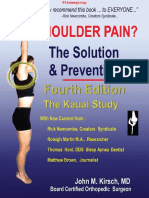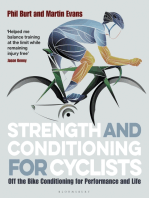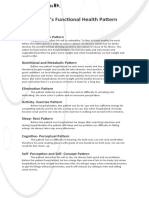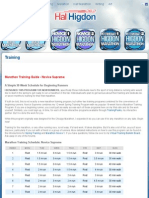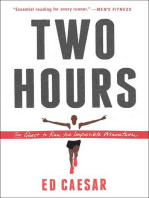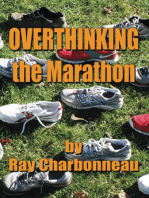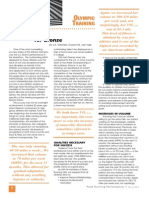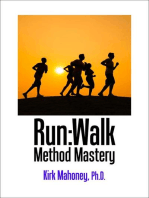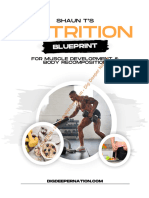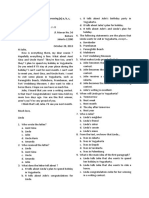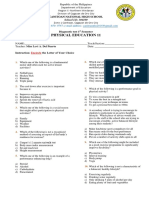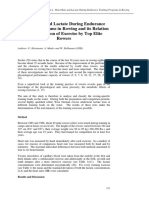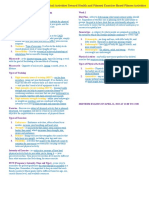001 Run Less Run Faster - Marathon Training With The FIRST Method
001 Run Less Run Faster - Marathon Training With The FIRST Method
Uploaded by
Eduardo MedinaCopyright:
Available Formats
001 Run Less Run Faster - Marathon Training With The FIRST Method
001 Run Less Run Faster - Marathon Training With The FIRST Method
Uploaded by
Eduardo MedinaOriginal Description:
Original Title
Copyright
Available Formats
Share this document
Did you find this document useful?
Is this content inappropriate?
Copyright:
Available Formats
001 Run Less Run Faster - Marathon Training With The FIRST Method
001 Run Less Run Faster - Marathon Training With The FIRST Method
Uploaded by
Eduardo MedinaCopyright:
Available Formats
Run Less Run Faster - Marathon Training With the
FIRST Method
Despite popular belief, the best way to train for a distance race and improve your running abilities is not
just a matter of logging more miles in training. As outlined in the book Run Less, Run Faster, a 3-day a
week (plus cross training) plan, where each run has a specific pace and purpose, has been proven to
help many athletes reach their goals. It was developed by the Furman Institute of Running and Scientific
Training (FIRST).
The program specifies one speed or interval workout, one tempo run, and one long run per week.
Speed: Short, fast workouts repeated several times with short rest intervals in between. For example:
Run 800 meters 4 times, jogging 1 lap (400 meters) in between. The interval workouts specified in this
program will help you increase your running economy, running speed and VO2Max (or the ability to use
your Oxygen supply most efficiently). Many runners see an immediate improvement once they start
incorporating speedwork into their routine.
Tempo: Tempo runs are medium-distance runs at a "comfortably-hard" pace. The goal is to maintain a
fast pace (faster than your race goal pace if you're training for a longer distance race) for several miles.
An example tempo run might be to run 5 miles at 15 seconds per mile faster than your 5K pace. The
tempo runs specified in this program will help you increase your lactate threshold, or the ability to keep
lactic acid from accumulating in your blood cells at higher intensities. In other words, it will help you
maintain a faster pace longer.
Long: Most runners are familiar with the long run. Gradually increase distance in the weeks before a
race so you are comfortable and confident in your ability to finish. In addition to the psychological
improvements, the long run lets your muscles gradually adapt to the longer distances, so you're less
likely to get hurt trying to run much farther than you've recently run. The main difference between this
program and many others is the recommended pace for these long runs. In some other programs, either
long run pace does not matter at all, or you're told to run at least 1.5-2 minutes per mile slower than
race pace. Here, most long runs are run either at or within 30 seconds of race pace. You will finish each
workout on pace to hit your goals!
Cross Training: Instead of another 1-3 days of running each week, the FIRST program eliminates those
extra "junk" miles and replaces them with cross-training exercises such as biking or swimming. This way,
you build just as much cardiovascular fitness without adding unnecessary stress to your body.
You might also like
- Shoulder Pain The Solution Prevention Fourth EditionDocument120 pagesShoulder Pain The Solution Prevention Fourth EditionMarko Štambuk97% (33)
- Lore of Running 4th Ed PDFDocument946 pagesLore of Running 4th Ed PDFwooyann67% (12)
- Nick Symmonds 2012 Daily Training Log Ebook PDFDocument60 pagesNick Symmonds 2012 Daily Training Log Ebook PDFNick Chock100% (2)
- Norwegian Method: The Culture, Science, and Humans Behind the Groundbreaking Approach to Elite Endurance PerformanceFrom EverandNorwegian Method: The Culture, Science, and Humans Behind the Groundbreaking Approach to Elite Endurance PerformanceNo ratings yet
- Jack Daniels - Daniels' Running Formula-Human Kinetics (1998)Document288 pagesJack Daniels - Daniels' Running Formula-Human Kinetics (1998)bequeijicrocre100% (6)
- Bill Rodgers 1974 LOGDocument28 pagesBill Rodgers 1974 LOGbobing4barker100% (2)
- Childhood Obesity Apa PaperDocument13 pagesChildhood Obesity Apa Paperapi-3018616020% (1)
- Jogging The Lydiard Way With Pics 4Document46 pagesJogging The Lydiard Way With Pics 4Linming Ho100% (1)
- ChiRunning: A Revolutionary Approach to Effortless, Injury-Free RunningFrom EverandChiRunning: A Revolutionary Approach to Effortless, Injury-Free RunningRating: 3.5 out of 5 stars3.5/5 (127)
- Brooks 10K Training Plan - Advanced PDFDocument4 pagesBrooks 10K Training Plan - Advanced PDFBrooksRunningNo ratings yet
- The Science of the Marathon and Art of Variable Pace RunningFrom EverandThe Science of the Marathon and Art of Variable Pace RunningRating: 5 out of 5 stars5/5 (1)
- The World of Cycling According To G by Geraint Thomas - Unexpected ConsequencesDocument5 pagesThe World of Cycling According To G by Geraint Thomas - Unexpected ConsequencesQuercus BooksNo ratings yet
- Strength and Conditioning for Cyclists: Off the Bike Conditioning for Performance and LifeFrom EverandStrength and Conditioning for Cyclists: Off the Bike Conditioning for Performance and LifeNo ratings yet
- Gordon S Functional Health Pattern For DMDocument2 pagesGordon S Functional Health Pattern For DMJamie HaravataNo ratings yet
- The Verheul MethodDocument2 pagesThe Verheul MethodLudwig Deconinck100% (2)
- Three Hour Marathon Training PlanDocument2 pagesThree Hour Marathon Training PlanGreg StrosakerNo ratings yet
- Athletic Training Lydiard (Best)Document45 pagesAthletic Training Lydiard (Best)Ronald George100% (2)
- Chris Lear - Running With The Buffaloes - A Season Inside With Mark Wetmore, Adam Goucher, and The University of Colorado Men's Cross Country Team (2011, Lyons Press) PDFDocument291 pagesChris Lear - Running With The Buffaloes - A Season Inside With Mark Wetmore, Adam Goucher, and The University of Colorado Men's Cross Country Team (2011, Lyons Press) PDFThales Speroni100% (1)
- Hal Higdon Training ProgramsDocument3 pagesHal Higdon Training ProgramsMichael Sherman100% (3)
- MAF Method SummaryDocument8 pagesMAF Method SummaryJavier Fernández CondeNo ratings yet
- Chasing Excellence: The Remarkable Life and Inspiring Vigilosophy of Coach Joe I. VigilFrom EverandChasing Excellence: The Remarkable Life and Inspiring Vigilosophy of Coach Joe I. VigilNo ratings yet
- Strength Training for Triathletes: The Complete Program to Build Triathlon Power, Speed, and Muscular EnduranceFrom EverandStrength Training for Triathletes: The Complete Program to Build Triathlon Power, Speed, and Muscular EnduranceRating: 4.5 out of 5 stars4.5/5 (2)
- Summary of Jack Daniels's Daniels' Running FormulaFrom EverandSummary of Jack Daniels's Daniels' Running FormulaRating: 5 out of 5 stars5/5 (1)
- Tom Danielson's Core Advantage: Core Strength for Cycling's Winning EdgeFrom EverandTom Danielson's Core Advantage: Core Strength for Cycling's Winning EdgeNo ratings yet
- 5K by Jeff GallowayDocument2 pages5K by Jeff GallowaySas ParakNo ratings yet
- Lydiard Iowa 99Document33 pagesLydiard Iowa 99Jill ClarkNo ratings yet
- Lydiard and CanovaDocument17 pagesLydiard and CanovareklaminisNo ratings yet
- Your First Triathlon: Race-Ready in 5 Hours a Week, 2nd EditionFrom EverandYour First Triathlon: Race-Ready in 5 Hours a Week, 2nd EditionRating: 4.5 out of 5 stars4.5/5 (6)
- Summary of Bill Pierce & Scott Murr's Runner's World Run Less Run FasterFrom EverandSummary of Bill Pierce & Scott Murr's Runner's World Run Less Run FasterRating: 1 out of 5 stars1/5 (1)
- US Navy Seals Ermagherherd WorkoutsDocument2 pagesUS Navy Seals Ermagherherd WorkoutsDan IftincaNo ratings yet
- Hell on Two Wheels: An Astonishing Story of Suffering, Triumph, and the Most Extreme Endurance Race in the WorldFrom EverandHell on Two Wheels: An Astonishing Story of Suffering, Triumph, and the Most Extreme Endurance Race in the WorldRating: 4 out of 5 stars4/5 (29)
- Your Best Triathlon: Advanced Training for Serious TriathletesFrom EverandYour Best Triathlon: Advanced Training for Serious TriathletesRating: 4.5 out of 5 stars4.5/5 (6)
- NRC Injury Free RunningDocument72 pagesNRC Injury Free RunningSylvain Sella100% (6)
- Training of Champion Middle Distant RunnersDocument2 pagesTraining of Champion Middle Distant RunnersAbhiNo ratings yet
- TrainingPeaks How To Start Training With Power Ebook PDFDocument23 pagesTrainingPeaks How To Start Training With Power Ebook PDFbhills100% (1)
- Run with Power: The Complete Guide to Power Meters for RunningFrom EverandRun with Power: The Complete Guide to Power Meters for RunningRating: 3 out of 5 stars3/5 (1)
- Summary and Analysis of Born to Run: A Hidden Tribe, Superathletes, and the Greatest Race the World Has Never Seen: Based on the Book by Christopher McDougallFrom EverandSummary and Analysis of Born to Run: A Hidden Tribe, Superathletes, and the Greatest Race the World Has Never Seen: Based on the Book by Christopher McDougallRating: 4 out of 5 stars4/5 (4)
- 10K Training Nike Alberto SalazarDocument1 page10K Training Nike Alberto SalazarAhmad Almatari100% (3)
- The Athlete Inside: The Transforming Power of Hope, Tenacity, and FaithFrom EverandThe Athlete Inside: The Transforming Power of Hope, Tenacity, and FaithRating: 4.5 out of 5 stars4.5/5 (3)
- 1:59: The Sub-Two-Hour Marathon Is Within Reach—Here's How It Will Go Down, and What It Can Teach All Runners about Training and RacingFrom Everand1:59: The Sub-Two-Hour Marathon Is Within Reach—Here's How It Will Go Down, and What It Can Teach All Runners about Training and RacingNo ratings yet
- Arthur LydiardDocument29 pagesArthur LydiardItzel de JesusNo ratings yet
- Two Hours: The Quest to Run the Impossible MarathonFrom EverandTwo Hours: The Quest to Run the Impossible MarathonRating: 5 out of 5 stars5/5 (1)
- The Quest For BronzeDocument4 pagesThe Quest For BronzepeakrunningNo ratings yet
- Autoregulation - The Definitive Guide ToDocument12 pagesAutoregulation - The Definitive Guide ToAnonymous soN3iqwKFA100% (2)
- Pose Running DRILLSDocument7 pagesPose Running DRILLSremlorean50% (2)
- Total Heart Rate Training Customize and Maximize 1569755620Document4 pagesTotal Heart Rate Training Customize and Maximize 1569755620Arun Kumar KvNo ratings yet
- Brooks 5K Advanced Training Plan - KilometersDocument4 pagesBrooks 5K Advanced Training Plan - KilometersBrooksRunning100% (1)
- Barefoot Running Step by Step - Ken Bob Saxton PDFDocument406 pagesBarefoot Running Step by Step - Ken Bob Saxton PDFThiago Sarraff67% (3)
- Triathlon Swimming: Master Open-Water Swimming with the Tower 26 MethodFrom EverandTriathlon Swimming: Master Open-Water Swimming with the Tower 26 MethodNo ratings yet
- HEALTH Quarter 4 - Module 1 Gateway DrugsDocument22 pagesHEALTH Quarter 4 - Module 1 Gateway DrugsMarianna GarciaNo ratings yet
- ST Nutrition BlueprintDocument3 pagesST Nutrition Blueprintimym2909No ratings yet
- Jawaban Remed B.ingDocument6 pagesJawaban Remed B.ingFenko PutraNo ratings yet
- Pomegranate CosmopolitanDocument3 pagesPomegranate Cosmopolitanlechiquita1No ratings yet
- Principles of Nutritional AssesmentDocument6 pagesPrinciples of Nutritional AssesmentHendro Dan MithochanNo ratings yet
- PE12 Act3Document4 pagesPE12 Act3Ira Jane CaballeroNo ratings yet
- Unit-III HFNDocument52 pagesUnit-III HFNSachin ShrivastavNo ratings yet
- Why Do You Need Inbody 570?Document1 pageWhy Do You Need Inbody 570?Rizky AdriansyahNo ratings yet
- LM Week 1 PDFDocument16 pagesLM Week 1 PDFEdNo ratings yet
- A New Approach To Monitoring Resistance Training: Keywords: Exercise Intensity Perceived Exertion PeriodizationDocument6 pagesA New Approach To Monitoring Resistance Training: Keywords: Exercise Intensity Perceived Exertion PeriodizationDanielBCNo ratings yet
- Reference FinaleDocument6 pagesReference Finale2059257No ratings yet
- Soal UAS Bahasa InggrisDocument5 pagesSoal UAS Bahasa InggrisRangga FirmansyahNo ratings yet
- 5 3 1 CalculatorDocument24 pages5 3 1 CalculatorJohn ZimmermanNo ratings yet
- Diagnostic Test FINAL PE 11 and 12Document5 pagesDiagnostic Test FINAL PE 11 and 12LEVI DEL PUERTONo ratings yet
- Indonesian YouthDocument3 pagesIndonesian Youthsherly poltekkes sarjana ahli giziNo ratings yet
- Level 4 - Chapter 4 - Advanced PhysiologyDocument21 pagesLevel 4 - Chapter 4 - Advanced PhysiologyyangNo ratings yet
- 10 Leading Causes of Weight Gain and Obesity PDFDocument9 pages10 Leading Causes of Weight Gain and Obesity PDFNaveen ChoudharyNo ratings yet
- Review: Shift Work, Sleep, and Sleepiness - Differences Between Shift Schedules and SystemsDocument14 pagesReview: Shift Work, Sleep, and Sleepiness - Differences Between Shift Schedules and SystemstarsiahningsihNo ratings yet
- PEH1 Module 4-Worksheet 3Document3 pagesPEH1 Module 4-Worksheet 3Chrislyn JumawidNo ratings yet
- PATHFit 2 Midterm Reviewer - Exercise-Based Fitness ActivitiesDocument1 pagePATHFit 2 Midterm Reviewer - Exercise-Based Fitness ActivitiesChelden100% (1)
- What Are The Health Benefits of ExerciseDocument2 pagesWhat Are The Health Benefits of ExerciseJoycs PintoNo ratings yet
- A Nutrition and Conditioning Intervention For Natural Bodybuilding Contest Preparation: Case StudyDocument12 pagesA Nutrition and Conditioning Intervention For Natural Bodybuilding Contest Preparation: Case StudyTHIMMAPPANo ratings yet
- Zaldy T. Perez Jr. Bsce - 5 Saint Joseph Institute of Technology College of Engineering and ArchitectureDocument2 pagesZaldy T. Perez Jr. Bsce - 5 Saint Joseph Institute of Technology College of Engineering and ArchitectureJuvelyn DaculaNo ratings yet
- Download Full Nutrition for Health and Health Care 8th Edition Linda Kelly Debruyne PDF All ChaptersDocument37 pagesDownload Full Nutrition for Health and Health Care 8th Edition Linda Kelly Debruyne PDF All Chaptersnaddyhoaks98No ratings yet
- Nutrition Intervention For Bariatric Surgery Patients PDFDocument98 pagesNutrition Intervention For Bariatric Surgery Patients PDFMayadaNo ratings yet
- Reverse Lactate Threshold: A Novel Single-Session Approach To Reliable High-Resolution Estimation of The Anaerobic ThresholdDocument11 pagesReverse Lactate Threshold: A Novel Single-Session Approach To Reliable High-Resolution Estimation of The Anaerobic ThresholdkenzullNo ratings yet
- PCRMDietary GuidelinesDocument42 pagesPCRMDietary GuidelinesSatyawira Aryawan DengNo ratings yet
- Long Test in P.E. and Health 2Document1 pageLong Test in P.E. and Health 2Philip Andrew Briola UndagNo ratings yet
